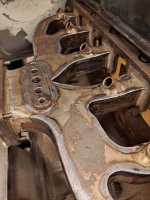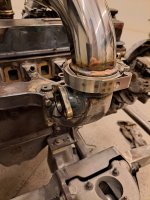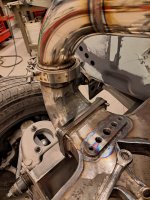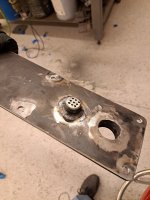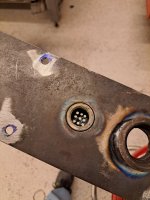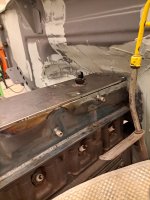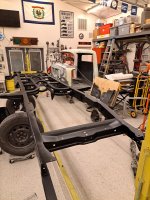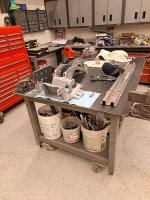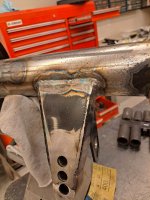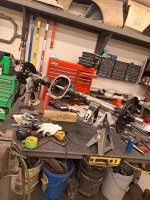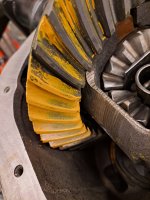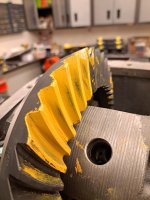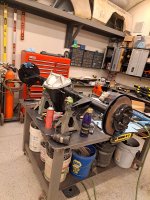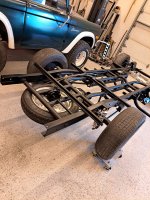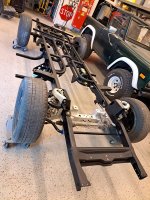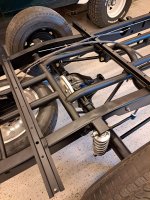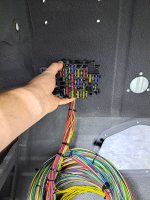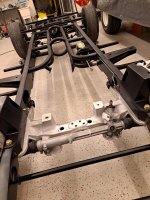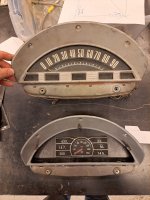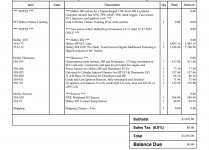If you still plan on using the T-5 and demand reliability I hope the rig is really light or traction limited, high torque engines with some weight and traction are not the T-5's forte.I wanted to start a new thread as the other was cluttered with what ifs … My apologies, but I think I am slowly starting to iron out a few things and wanted to keep this thread strictly looking at the M112 build.
As stated previously I'd ideally like 300 HP and 400 ft-lbs. But if I am sinking this kind of money into it, why stop there....so I would like the option of increasing the boost and maybe going higher. BUT IT HAS TO BE RELIABLE.
Here is what I have:
-87 4.9L
-The head completed: 2.02 Intake, 1.72 Exhaust, 1.72 Rockers, and a CNC Head Port.
-C5AE 240 no hole rods
-Custom sheet metal intake and a Clifford Intake
-Dynomax Headers
-T-5 3.35 1st, 1.93 2nd, 1.29 3rd, 1.00 4th, .68 5th
-2.78:1 Rearend
-Eaton M112 with 2.5:1 drive ratio (I can and may need to go to a larger pulley on the blower as discussed in previous threads).
Discussion/Questions:
1. I have decided 100% on a Holley EFI system (Megasquirt is ruled out). I have not decided on using the HP or Sniper unit yet. I want to discuss each option below.
2. As listed above I have already purchased remanufactured 240 rods with ARP studs, peened and polished. Will these handle the stated power, where's the cut off? or should I sell them and go for the Compstar Rods
3. I have decided to run a water/methanol injection system and for go any type of intercooler. In normal driving I wont be in the boost that much, mainly just once in awhile showing off for other car guys.
4. According to FTF in another post, the Felpro #1024 is about the best Head Gasket out there. What PSI do you think this will hold up to? OR will I need to go to copper and an O-ring (again it is a daily driver so I don't want a leaky head gasket).
5. I have a normal nodular cast crank, will it hold?
6. Which side of the motor should I mount the Supercharger on. Personally I like the drivers side. It just fits better, but will require me to pipe up and over the valve cover to the intake. It also makes bracing the supercharger easier because I do not have to contend with the headers. I think this will also help reduce heat in the supercharger.
Option 1. If I mount it on the drivers side, it eliminates the possibility of using the Sniper system in a draw through setup, due to the additional charge of air in the intake possibly exploding. This forces me to use the HP system with a fuel rail.
I actually plan to run the pulley right through the powersteering pump hole. I have electric power steering installed so I don't need the pump.

Option 2. Now, if I were to mount it on the passenger side, I could mount it directly to the intake. This gets complicated due to bracing it, and it would require me to relocate the alternator to the driver side, in order to keep my belt routed correctly and have good wrap on everything. Not impossible, but additional work. This does however allow me to use the simplified sniper setup, no fuel rail, easier tuning etc.
6. Ignition (at least in my mind) now thanks to the guys on this forum has gotten simpler.
Sniper: As of now, I can use the TFI unit, Holley harness, and an Aftermarket Ign. Box to control timing. Or if I am lucky they will have the plug and play distributor out by the time I get there.
The other Sniper option is to modify all the vanes to the same width on the TFI distributor and add a crank signal. Then I think the Sniper is capable of controlling the timing without an aftermarket box. (That's what I gather from the Holley forum anyhow).
HP: I can pickup cheap used COP (Or coil near plug rather) from an LS (including plug wires). Reuse the TFI distributor, remove the vanes for my cam signal and create a cap as you guys have mentioned before. The worst part about this will be the bulky harness that comes with it. I'll have to figure out how to clean that up. Or possibly find a donor cam sync. This will require a 60-2 crank trigger.
I guess to summarize things, I'd really like to hear your input on the water/methanol, the 240 rods, head gasket, nodular crank, and which side of the motor/holley system to go with.
I am currently talking to a few different local engine builders. The one that is retired (built for the the Petty's (I think) back in the 80's and 90's), has raced 240's and 300's before, but I doubt he has any experience to help me with the fuel injection if I need it. He seemed very interested in helping build the six. The other is younger and worked for Joe Gibbs racing. Currently builds $20k plus turboed engines for mudders. I think with tuning he would be able to nail it down, but I am not so sure I can afford him, nor do I think he is that interested in my project.
You are using an out of date browser. It may not display this or other websites correctly.
You should upgrade or use an alternative browser.
You should upgrade or use an alternative browser.
M112 - 300 Build for the '56
- Thread starter clintonvillian
- Start date
80f150custom
Well-known member
Clintonvillian, everything looks amazing! I have a couple questions for you. I'm sorry if they have already been answered. What is the main type of driving that will be done with this vehicle? I'm doing something similar and am interested in the suspension modifications you are making. What rear end are you using? Also what are you using for the crank pulley? If all of this was mentioned somewhere else feel free to send me a link to it or let me know which forum and I'll search it up, thanks Jason
Last edited:
clintonvillian
Famous Member
THE FRENCHTOWN FLYER
Top Poster
VIP
Subscriber
Supporter 2023
Supporter 2022
Supporter 2021
Supporter 2020
REDLINE 10K
Supporter 2018
Nice welding.
That intake does look vaguely familiar.
That intake does look vaguely familiar.
clintonvillian
Famous Member
clintonvillian
Famous Member
How am I going to break this engine in, and dyno it?
I can break it in mounted in the truck, my builder has an engine dyno, but it seems like a lot of work since Im using HP.
But then again it may be worth the extra effort to get it on his dyno or a stand to work the kinks out.
I can break it in mounted in the truck, my builder has an engine dyno, but it seems like a lot of work since Im using HP.
But then again it may be worth the extra effort to get it on his dyno or a stand to work the kinks out.
I cannot see how your BOV location would be a problem with the rear cylinders, it is plenty far enough away.
clintonvillian
Famous Member
Crower 284HDP (19205)
.509”/517” 220/222 284/290
The lift is with a 1.6 ratio rocker.
What 1.72 rocker arms are you using?
If my calculations are right that lift becomes .565, the spring limit is .600. Is that pushing it too close?
Do those spring loads look to high?
Lastly what type of idle will this cam have?
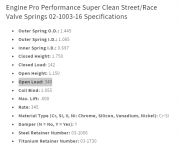
The 345 spring rate is good.
You only need about 125 lbs closed.
If you can install the spring at 1.800" the closed pressure will be 125 lbs and the open pressure at .565" lift will be 320 lbs.
There will be .745" before coil bind.
What is the retainer height above the spring perch on the head?
You only need about 125 lbs closed.
If you can install the spring at 1.800" the closed pressure will be 125 lbs and the open pressure at .565" lift will be 320 lbs.
There will be .745" before coil bind.
What is the retainer height above the spring perch on the head?
clintonvillian
Famous Member
Not sure how to measure that, or how accurate that measurement needs to be?The 345 spring rate is good.
You only need about 125 lbs closed.
If you can install the spring at 1.800" the closed pressure will be 125 lbs and the open pressure at .565" lift will be 320 lbs.
There will be .745" before coil bind.
What is the retainer height above the spring perch on the head?
Do I need to dissassemble?
You remove the spring and install the retainer back on the valve stem.Not sure how to measure that, or how accurate that measurement needs to be?
Do I need to dissassemble?
Then you cut a piece of coat hanger or any other rod that size and file the length until it fits under the retainer in place of the spring.
Then measure the length of the rod.
Are the springs you posted above on the head now?
Last edited:
clintonvillian
Famous Member
yesYou remove the spring and install the retainer back on the valve stem.
Then you cut a piece of coat hanger or any other rod that size and file the length until it fits under the retainer in place of the spring.
Then measure the length of the rod.
Are the springs you posted above on the head now?
can you remove a valve spring to check the installed height using the method I described?
clintonvillian
Famous Member
clintonvillian
Famous Member
clintonvillian
Famous Member
THE FRENCHTOWN FLYER
Top Poster
VIP
Subscriber
Supporter 2023
Supporter 2022
Supporter 2021
Supporter 2020
REDLINE 10K
Supporter 2018
Wow - what beautiful chassis work. So much to like. Did you narrow the Crown Vic IFS yourself? What are your coil-over spring rates? The rear ones look a little light to my eyes.
PSIG
Famous Member
Awesome work.  For tuning, you can't rely on the generic auto-tune defaults, as you want full control for peak performance with zero bad stuff like detonation. To do that you need to 'see' how the engine is responding in every way, and find optimal values. One of the best tools for data analysis is MegaLogViewer HD from EFI Analytics. It is my workhorse in tuning, as the Holley (or other) interface is primarily for monitoring and settings. You can export the Holley logs to *.csv files and open them in MLV. It can also "auto-tune", but with permissions and filters to avoid the standard settings steering you in the wrong direction occasionally.
For tuning, you can't rely on the generic auto-tune defaults, as you want full control for peak performance with zero bad stuff like detonation. To do that you need to 'see' how the engine is responding in every way, and find optimal values. One of the best tools for data analysis is MegaLogViewer HD from EFI Analytics. It is my workhorse in tuning, as the Holley (or other) interface is primarily for monitoring and settings. You can export the Holley logs to *.csv files and open them in MLV. It can also "auto-tune", but with permissions and filters to avoid the standard settings steering you in the wrong direction occasionally. 
Once you're comfy with using it (it starts-off feeling like a Matrix screen), a 'big picture' emerges to see what the engine is doing, and how it responds in various ways under various conditions. A big plus for guiding tuning safely, effectively and quickly. Building with parts to withstand det was necessary in the old days, as it was difficult to avoid. Today we tune to see and avoid approaching det so it doesn't happen in the first place, even without knock sensors. It's a new world and data guiding control is a wonderful thing.
Once you're comfy with using it (it starts-off feeling like a Matrix screen), a 'big picture' emerges to see what the engine is doing, and how it responds in various ways under various conditions. A big plus for guiding tuning safely, effectively and quickly. Building with parts to withstand det was necessary in the old days, as it was difficult to avoid. Today we tune to see and avoid approaching det so it doesn't happen in the first place, even without knock sensors. It's a new world and data guiding control is a wonderful thing.
clintonvillian
Famous Member
Wow - what beautiful chassis work. So much to like. Did you narrow the Crown Vic IFS yourself? What are your coil-over spring rates? The rear ones look a little light to my eyes.
Fronts are 550's, Rear are 225's. I'm afraid I'm a little too stiff on the rear.
Yes I did the narrowing, I need more practice Tigging aluminum. I plated it, bolted it and added a steel plate across the bottom for additional insurance.

Similar threads
- Replies
- 15
- Views
- 881
- Replies
- 3
- Views
- 800
All Small Six
Starting new build
- Replies
- 114
- Views
- 8K
- Replies
- 10
- Views
- 2K

